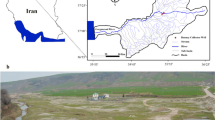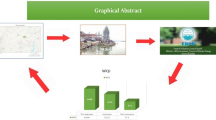Abstract
The poor water quality, bacterial contamination, seasonal variation, uncertainty in monsoon, lack of sustainability etc. are some major challenges of the water sector in the Himalayan region of India. To tackle the major problem of water quality, River Bank Filtration (RBF) has been applied in Uttarakhand as a domestic water pre-treatment technology. This technique is found to be effective for removal of turbidity and bacterial contamination present in surface water of four rivers of Uttarakhand, namely Alaknanda, Mandakini, East Nayar, and Pinder. The present paper reveals the improved water quality of rivers produced through RBF in a sustainable manner as compared to surface river water being supplied for drinking purpose. The classification of water quality using Pearson correlation followed by Piper trilinear and Chadha’s diagrams further provide support to the better water quality through RBF. Moreover, the results of Water Quality Index (WQI) also reflect the excellent water quality with ‘A-Grade’ of all river water samples obtained after RBF process in comparison to normal river water samples having good water quality with ‘B-Grade’ except the Srinagar site, where the river water sample was found to be unsuitable for drinking purpose with ‘E-Grade’. Alluvial deposits of RBF sites along the banks of the four rivers show the potential of replication of RBF at large scale in the hill state of Uttarakhand.




Similar content being viewed by others
References
Abdel-Lah AK (2013) Riverbank filtration for water supply in semi arid environment. J Eng Sci 41(3):840–850
Akoteyon IS, Omotayo AO, Soladoye O, Olaoye HO (2011) Determination of water quality index and suitability of urban river for municipal water supply in Lagos-Nigeria. Eur J Sci Res 54:263–271
APHA (2005) Standard methods for the examination of water and waste waters. American Public Health Association, Washington
Balan IN, Shivakumar M, Kumar PDM (2012) An assessment of ground water quality using water quality index in Chennai Tamil Nadu India. Chron Young Sci 3:146–150
BIS (1991) Specifications for drinking water IS, vol 10500. Bureau of Indian Standards, New Delhi, p 1991
BIS (2004) Specifications for drinking water IS: 10500:2004 2nd revision. Bureau of Indian Standards, New Delhi
Brown RM, McClelland NI, Deininger RA, Tozer RG (1970) Water quality index-do we dare? Water Sew Works 117:339–343
Cady P (2011) A riverbank filtration demonstration project on the Kali river. Master’s thesis, University of Rhode Island, Dandeli, Karnataka, India, p 66
Chadha DK (1999) A proposed new diagram for geochemical classification of natural waters and interpretation of chemical data. Hydrogeol J 7(5):431–439
Chauhan A, Singh S (2010) Evaluation of Ganga water for drinking purpose by water quality index at Rishikesh, Uttarakhand, India. Rep Opin 2:53–61
Dash RR, Mehrotra I, Kumar P, Grischek T (2008) Lake bank filtration at Nainital India: water-quality evaluation. Hydrogeol J 16:1089–1099
Dash RR, Prakash EVPB, Kumar P, Mehrotra I, Sandhu C, Grischek T (2010) River bank filtration in Haridwar India: removal of turbidity organics and bacteria. Hydrogeol J 18:973–983
de Vet WWJM, van Genuchten CCA, van Loosdrecht MCM, van Dijk JC (2009) Water quality and treatment of river bank filtrate. Drink Water Eng Sci Discuss 2:127–159
de Vet WWJM, van Genuchten CCA, van Loosdrecht MCM, van Dijk JC (2010) Water quality and treatment of river bank filtrate. Drink Water Eng Sci 3:79–90
Derx J, Blaschke AP, Farnleitner AH, Pang L, Bloschl G, Schijven JF (2013) Effects of fluctuations in river water level on virus removal by bank filtration and aquifer passage—a scenario analysis. J Contam Hydrol 147:34–44
Grischek T, Schoenheinz D, Ray C (2002) Siting and design issues for riverbank filtration schemes. In: Ray C, Melin G, Linsky RB (eds) Riverbank filtration: improving source-water quality. Kluwer Academic, Dordrecht, pp 291–302
Jain CK, Bandyopadhyay A, Bhadra A (2010) Assessment of ground water quality for drinking purpose, District Nainital, Uttarakhand, India. Environ Monit Assess 166:663–676
Jaramillo M (2012) Riverbank filtration: an efficient and economical drinking-water treatment technology. Dyna 171:148–157
Joshi DM, Kumar A, Agrawal N (2009) Studies on physicochemical parameters to assess the water quality of river Ganga for drinking purpose in Haridwar district. Ras J Chem 2:195–203
Juttner F (1995) Elimination of terpenoid odorous compounds by slow sand and river bank filtration of the Ruhr River, Germany. Water Sci Technol 31(11):211–217
Juttner F (1999) Efficacy of bank filtration for the removal of fragrance compounds and aromatic hydrocarbons. Water Sci Technol 40(6):123–128
LeChevallier MW, Au KK (2004) Water treatment and pathogen control: process efficiency in achieving safe drinking water. IWA, London. http://www.who.int/water_sanitation_health/dwq/en/watreatpathtoc.pdf. Accessed 15 Feb 2013
Lorenzen G, Sprenger C, Taute T, Pekdeger A, Mittal A, Massmann G (2010) Assessment of the potential for bank filtration in a water-stressed megacity (Delhi, India ). Environ Earth Sci 61(7):1419–1434
Luckins N, Mehrotra I, Kumar P, Grischek T (2011) Riverbank filtration as an alternative to pre-chlorination: a case study at Mathura. In: Dobhal R, Grischek T, Uniyal HP, Uniyal DP, Sandhu C (eds) Drinking water: source, treatment and distribution. Uttarakhand State Council for Science and Technology, Dehradun, pp 125–135
Ojha CSP (2012) Simulating turbidity removal at a river bank filtration site in India using SCS-CN approach. J Hydrol Eng 17(11):1240–1244
Oluyemi EA, Adekunle AS, Adenuga AA, Makinde WO (2010) Physico-chemical properties and heavy metal content of water sources in Ife North local government area of Osun state, Nigeria. African J Environ Sci Technol 4(10):691–697
Piper AM (1944) A graphical procedure in the geochemical interpretation of water analysis. Trans Am Geophys Union 25:914–923
Prasad T, Varma AK, Singh BP (2009) Water supply to Patna through river bank filtration: problems and prospects. In: Proc of the international conference of water, environment, energy and society WEES, New Delhi, 12–16 January 2009, pp 1348–1357
Rawat V, Jha SK, Bag A, Singhai M, Rawat CM (2012) The bacteriological quality of drinking water in Haldwani block of Nainital district, Uttarakhand, India. J Water Health 10(3):465–470
Ray C (2008) Worldwide potential of riverbank filtration. Clean Technol Environ Policy 10:223–225
Sandhu C, Grischek T, Kumar P, Ray C (2011) Potential for riverbank filtration in India. Clean Technol Environ Policy 13:295–316
Schubert J (2002) Hydraulic aspects of riverbank filtration—field studies. J Hydrol 266:145–161
Semwal N, Akolkar P (2006) Water quality assessment of sacred Himalayan rivers of Uttaranchal. Curr Sci 91:486–496
Shamrukh M, Abdel-Wahab A (2008) Riverbank filtration for sustainable water supply: application to a large-scale facility on the Nile River. Clean Technol Environ Policy 10(4):351–358
Shamrukh M, Abdel-Wahab A (2011) Water pollution and riverbank filtration for water supply along river Nile, Egypt. In: Ray C, Shamrukh M (eds) Riverbank filtration for water security in desert countries. Springer, The Netherlands, pp 5–28
Shankar V, Eckert P, Ojha C, Konig CM (2009) Transient three-dimensional modeling of riverbank filtration at grind well field Germany. Hydrogeol J 17:321–326
Sharma SK, Amy G (2009) Bank filtration: a sustainable water treatment technology for developing countries. In: Proceedings of the 34th WEDC international conference. Addis Ababa, Ethiopia
Singh AK, Shah G, Sharma V (2012) Revival of defunct radial collector wells for urban water supply using river bank filtration technique in India. J Indian Water Works Assoc 49(4):24–39
Sontheimer H (1980) Experience with river bank filtration along the Rhine river. J AWWA, 386–390
Sprenger C, Lorenzen G, Pekdeger A (2012) Environmental tracer application and purification capacity at a riverbank filtration well in Delhi (India). J Ind Water Works Assoc, 25–32
Sudhakaran S, Lattemann S, Amy GL (2013) Appropriate drinking water treatment processes for organic micropollutants removal based on experimental and model studies—a multi-criteria analysis study. Sci Total Environ 442:478–488
Tyagi S, Sharma B, Singh P, Dobhal R (2013) Water quality assessment in terms of water quality index. J Am Water Resour Assoc 1(3):34–38
Tufenkji N, Ryan JN, Elimelech M (2002) The promise of bank filtration. Environ Sci Technol 36(21):422A–428A
Varadi Z (2013) Analytical calculation methods of riverbank filtration. In: Proceedings of the 1st global virtual conference, vol 8–12, Goce Delchev University Macedonia & Thomson Ltd. Slovakia, 8–12 April 2013, pp 573–578
Acknowledgements
The authors are thankful to the Water Technology Initiative (WTI) Programme, Department of Science and Technology, Government of India, New Delhi and Uttarakhand State Council for Science and Technology (UCOST), Dehradun for financial assistance provided for this work.
Author information
Authors and Affiliations
Corresponding author
Rights and permissions
About this article
Cite this article
Tyagi, S., Dobhal, R., Kimothi, P.C. et al. Studies of River Water Quality Using River Bank Filtration in Uttarakhand, India. Water Qual Expo Health 5, 139–148 (2013). https://doi.org/10.1007/s12403-013-0097-z
Received:
Revised:
Accepted:
Published:
Issue Date:
DOI: https://doi.org/10.1007/s12403-013-0097-z




